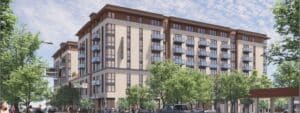More is less when it comes to the environment, and a report from Mountain View confirms it.
The draft Environmental Impact Report for the City’s General Plan, one of three important planning documents released on November 30, finds that planning for more homes in Mountain View is the “environmentally superior alternative.” LSA Associates, who completed the draft report for the City, explains that the decrease in environmental impacts is due to the reduction of per capita vehicle miles traveled (VMT). Simply put, this means people will drive less if there are more homes in Mountain View.
In a draft environmental impact report for a General Plan, cities typically look at multiple scenarios to compare relative impacts of land-use decisions. Usually, a city will examine a “Preferred Alternative” and an alternative with less development. In the case of Mountain View, in addition to the “Preferred Alternative,” which is the proposed draft General Plan, as well as a few alternatives with fewer homes, the City studied an “Increased Housing Alternative” which evaluated the impacts of nearly double the amount of additional homes called for in the “Preferred Alternative.”
Greenbelt Alliance is thrilled that Mountain View staff found that adding more homes would create real village centers that encourage people to drive less to jobs or stores. We hope that merely investigating an “Increased Housing Alternative,” to speak in planner-ese, will become standard operating procedure for Bay Area cities.
More jobs than homes
Mountain View has several big employers including Google and other technology giants. However, there are more jobs than homes, so many of the employees have to commute from outside of the city.
A comparison between the “Preferred Alternative” (draft General Plan) and the “Increased Housing Alternative” shows how these plans could potentially change the city of Mountain View by 2030:
| Housing | Jobs Housing Balance | Vehicular Miles Traveled | |
| Increased Housing Alternative | Adds 16,989 new homes | 1.6 jobs/home | 18.79 VMT per service population |
| Preferred Alternative | Adds 8,359 new homes | 1.9 jobs/home | 19.01 VMT per service population |
Also, the neighborhood north of downtown, which is one of the job centers, has few grocery stores, shops or restaurants. As a result people are reliant on their cars to get lunch or run errands.
While the “Increased Housing Alternative” is a step in the right direction, it still doesn’t provide enough homes to create the appropriate jobs housing balance in Mountain View.
In addition to providing more homes, the General Plan update is an important opportunity for the City of Mountain View to improve pedestrian amenities, access to public transportation, and much more. If you are interested in getting involved, please contact Ellie Casson.
What’s next?
Now that Mountain View has released three key documents that will guide future growth and could make Mountain View a less car centered community — the draft 2030 General Plan, the draft Environmental Impact Report and the draft Greenhouse Gas Reduction Program – it’s the public’s responsibility to read and comment on what they like and dislike in these plans. All are now available for review and comment at http://www.mountainview2030.com/
In the coming months, Mountain View will host several plan review meetings to answer questions about all three documents. Please mark your calendar — the Environmental Planning Commission will hold an information session and public hearing on Dec. 7 and Jan. 11, 2012.
To help advocates comment like a planning pro, Greenbelt Alliance and the Mountain View Coalition for Sustainable Planning will offer “How to Comment on an Environmental Impact Report” the first workshop in the series Planning for Change: How to be an effective advocate, on Dec. 13, 2011. For more information visit mvcsp.org.
To register for the workshop online visit here.




